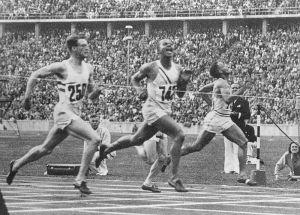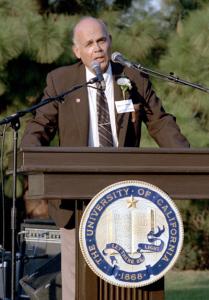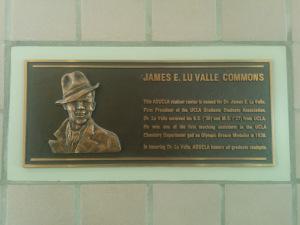
“Mr. LuValle has made an excellent record in his graduate work with us. He is classed in the upper group of our graduate students, despite the fact that the graduate students are very carefully selected and have in general great ability.”
–Linus Pauling, December 1938
James Ellis LuValle, known for his Olympic prowess as well as his contributions to the field of photochemistry, was born on November 10, 1912. LuValle, who would later come under the academic tutelage of Linus Pauling, showed promise in the classroom at an early age and developed an interest in chemistry not long after.
The same year that LuValle completed his bachelor’s degree in Chemistry at the University of California, Los Angeles, he also competed in the 1936 Olympics in Berlin. Competing alongside famed teammate Jessie Owens, LuValle was one of a handful of African Americans to participate in a games dominated by Adolf Hitler and the ascendant Nazi party.
LuValle had been a track star during his undergraduate years at UCLA, and during the Olympic Trials he clocked a personal best of 46.3 in the 400 meters. While competing in Germany, he posted the meet’s best qualifying times but finished third in the final, crossing the line at 46.8, just 0.3 seconds behind Archie Williams of the United States and Godfrey Brown of Great Britain.

LuValle, at right, finishing third in the 400 meters at the 1936 Berlin games.
While LuValle was appreciative of his experiences as an athlete, he always prioritized his scientific education. Notably, when considering his undergraduate options, LuValle turned down football and track scholarships to USC and Notre Dame on the premise that the sports programs at the two institutions had too much say in the academic arena.
Upon returning to the United States following the Berlin games, LuValle received good news: he had been accepted into a graduate program at UCLA and would be supported by an assistantship. Within a year, LuValle finished the curriculum and completed his thesis, “Photochemistry of Crotonaldeyhde at Elevated Temperatures.” During this period, LuValle also pushed the university’s Graduate Students Association to broaden its representation, and the organization was later integrated into the university’s student association, ASUCLA.
Eager to continue his education, LuValle applied to doctoral programs at Wisconsin, Harvard, and the California Institute of Technology. With support from the Julius Rosenwald Fund already in hand, Caltech’s offer of a teaching assistantship was all that LuValle needed to decide to move across town. He began his Ph.D. work under Pauling’s guidance in 1937 and is now believed to have been the first African American graduate student to enroll at Caltech.
While university assistantships were certainly nice, the Rosenwald Fund was key to LuValle’s pursuit of an advanced education. Established in 1917, the fund provided support to two categories of applicants: (1) African Americans, and (2) white Southerners who wished to work on a problem distinctive to the South and who expected to also build their careers in the South. The scholarship was open to men and women between the ages of 22 and 35.
While the fund was typically awarded for a single year and offered a stipend of $1,500, renewal was sometimes granted in exceptional cases, and LuValle certainly fit that mold. Ultimately he received a Rosenwald scholarship for both the 1937-38 and 1938-39 school years; by his own reckoning, he would not have been able to complete his doctoral training without this support.
While at Caltech, LuValle took several courses taught by Pauling, who had already risen to a high level of prominence within the academy. (LuValle later admitted to worshiping him during this time.) Pauling guided and mentored LuValle throughout his three-year “theoretical and experimental attack on the problem of resonance in conjugated unsaturated organic molecules containing oxygen.” Pauling viewed the project as very promising and was confident in his student’s ability to carry out the research.
In 1940 LuValle completed his Caltech Ph.D. in Physical Chemistry while also claiming a minor in Mathematics. His dissertation, titled “An Electron Diffraction Investigation of Several Unsaturated Conjugated Molecules,” detailed his research on the structure and deeper function of vinyl ether and oxalyl chloride, two important compounds that, at the time, had not been satisfactorily investigated. In his study of these two molecules, LuValle concluded that the conjugating power of two carbon-oxygen double bonds was equivalent to the conjugating power of two carbon-carbon double bonds.
LuValle’s laboratory work also revealed that thermolysis investigations could be conducted at much lower temperatures than had been used previously. In his Caltech research journal – which is now deposited in the Ava Helen and Linus Pauling Papers – LuValle likewise proposed a new slate of investigations using x-ray and denaturation techniques to study the structure of proteins.
Following U.S. entry into World War II, LuValle was invited by a member of the National Defense Research Committee to join a group of scientists who were actively working to develop a suite of weapons for near-term use. LuValle felt that his potential contributions to these efforts were absolutely necessary to helping insure the safety of the American people during World War II. In 1942 LuValle also returned briefly to Caltech to work with Pauling on war-related research, the nature of which neither was permitted to disclose. Based on his previous collaborations with Pauling, it is likely that LuValle contributed to the development of the blood plasma substitute oxypolygelatin, which was one of many government-funded projects that Pauling led during the war years.

After leaving Caltech for the second time, LuValle maintained a regular correspondence with his former mentor, discussing current research, ideas for the future, and personal matters as well. Pauling, who addressed LuValle as “Jimmy,” wrote many letters of recommendation for his former student, describing him as “reliable, industrious and conscientious,” blessed with an agreeable personality, and likely to “become a very useful member of a scientific organization.”
It did not take long for LuValle to find work. He landed first at Fisk University, a Historically Black College located in Nashville, Tennessee. However, he was quickly disappointed to discover how underdeveloped the Chemistry department was and also to learn that Fisk was facing major budget cuts for the following year. The school was eager to keep LuValle and offered him a raise in pay – from an annual salary of $1,800 to $1,900 – to stay, but LuValle ultimately decided to move north to Rochester, New York in order to work for the Eastman Kodak Company. Eastman Kodak proved to be a good fit, and during his time there LuValle made many significant advancements in the field of photochemistry.
In the years that followed, LuValle bounced back and forth between academia and the private sector as he pursued a wide array of career opportunities. Following Eastman Kodak, he worked as a lecturer at Brandeis University, and later conducted research at Technical Operations Inc., Fairchild Space and Defense Systems, Microstatics Laboratory, and the Palo Alto Research Center.
Pauling continued to support LuValle throughout all of these changes, writing letters of recommendation that commended his friendliness, industry, and willingness to work with everyone, and making particular note of his facility in the lab and his skill as an instructor. In these letters, Pauling often wrote that LuValle had compared favorably with a group of “extraordinary students” who had also attended Caltech during his years of association.
For the decade leading up to his retirement in 1984, LuValle served as Director of Undergraduate Chemistry Laboratories at Stanford University, a position that allowed him to develop summer programs for students of color interested in scientific fields. In 1987 he was nominated for the Caltech Distinguished Alumni Award by a Stanford colleague, chemistry professor David Mason, who lauded LuValle’s contributions to the field of photochemistry. In his nomination letter, Mason noted that
During the War and through 1953, [LuValle] was a top flight Chemist at Eastman Kodak and his research led to many innovations in the development and perfection of Kodachrome and Kodacolor processes. He holds important basic patents in the applied photochemical field together with Eastman Kodak.
Once again, Linus Pauling was happy to contribute a secondary letter of support for his former student, who would ultimately receive the award alongside four other prominent Caltech alumni: Morris Muskat (Gulf Oil Company), Stanley Pace (General Dynamics Corporation), Alvin Trivelpace (U.S. Department of Energy) and John Waugh (Massachusetts Institute of Technology).

On January 30, 1993, James LuValle passed away, the victim of a heart attack suffered in Te Anau, New Zealand. At the time of his death, LuValle was on holiday with his wife, Jean – a fellow chemist – and his three children, John, Michael, and Phyllis, all of whom pursued careers in the sciences. Over the course of his career, LuValle published about thirty-five technical papers and came to hold eight patents, and his legacy as an Olympian and major figure in photochemistry is utterly unique. Today, the campus student center at UCLA is known as the James E. LuValle Commons, in recognition of LuValle’s career and his contributions to student life at his alma mater.
